Living room lighting should ideally provide 10-20 lumens per square foot to create a welcoming and functional space. This balances ambient light with comfort, enhancing visibility while avoiding harshness. Incorporating layered lighting—combining ambient, task, and accent sources—can elevate the atmosphere and cater to various activities. Additionally, choosing the right color temperature enriches the experience, influencing mood and aesthetics. Exploring further details on placement and fixture types can reveal more about optimizing a living area’s luminosity.
Key Takeaways
- Aim for about 100-200 lumens per square foot to create a comfortable atmosphere in your living room.
- Use a mix of ambient, task, and accent lighting for balanced brightness and functional versatility.
- Incorporate warm white lighting (2700K-3000K) for a cozy and inviting feel.
- Consider the room’s size and color scheme, as lighter colors reflect light better than darker shades.
- Dimmable fixtures allow adjustable brightness for different activities and mood changes throughout the day.
Understanding Lumens and Lux
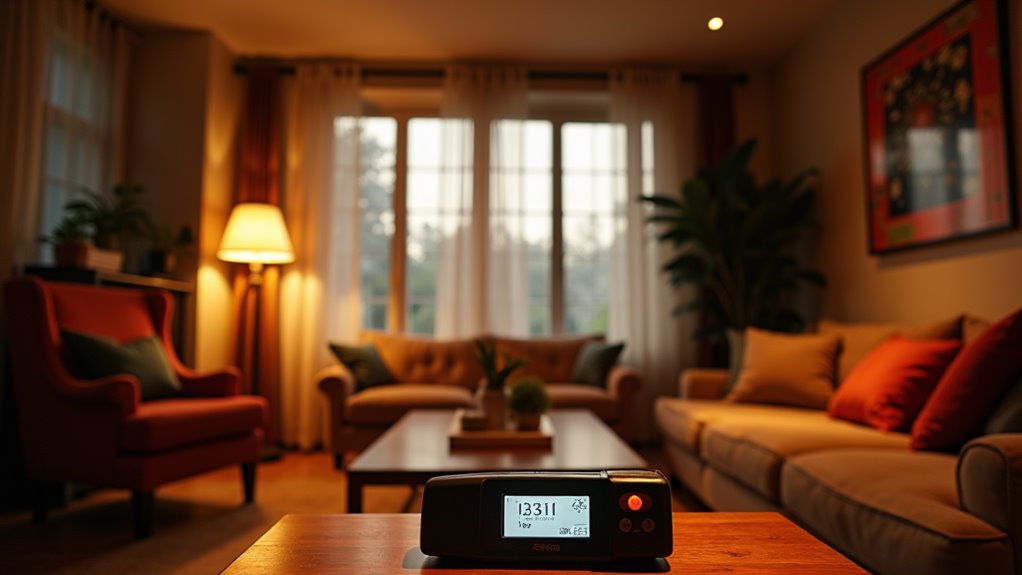
When considering the effectiveness of lighting in various spaces, it is essential to comprehend the distinct yet interconnected concepts of lumens and lux.
Lumens measure total visible light emitted by a source, serving as a critical indicator of brightness according to established lumen standards. A higher lumen rating signifies a brighter light fixture, which is crucial in energy-efficient lighting.
In contrast, lux measurements refer to illuminance, quantifying how much light reaches a specific surface area. One lux is equivalent to one lumen per square meter. Understanding the relationship between these two metrics allows for informed decisions in lighting design, ensuring that spaces are not only bright but adequately lit for their intended purposes, enhancing functionality and comfort for all activities. Moreover, office illumination typically requires around 500 lux to maintain an effective working environment.
General Living Room Brightness
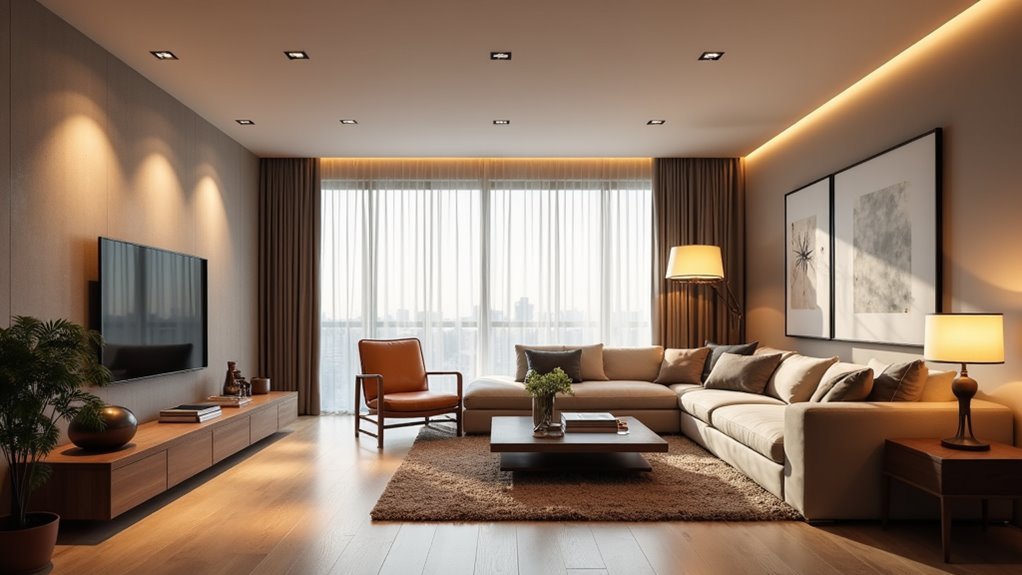
How do different factors influence the brightness of a living room? Various elements contribute to the overall brightness, such as room size, wall and furniture color, ceiling height, and natural light availability.
Larger spaces generally require increased illumination to feel inviting. Dark colors absorb light, while lighter shades enhance brightness, impacting light placement decisions. Higher ceilings may necessitate specific fixtures, like pendant lights, to distribute light effectively.
Additionally, individual design preferences play a crucial role; some favor a well-lit environment, while others prefer a cozier ambiance. To achieve balanced brightness, recommendations suggest 10-20 lumens per square foot, and flexibility in lighting schemes is vital for accommodating diverse activities and moods, ensuring comfort and visual appeal throughout the living space.
Task-Specific Lighting Requirements
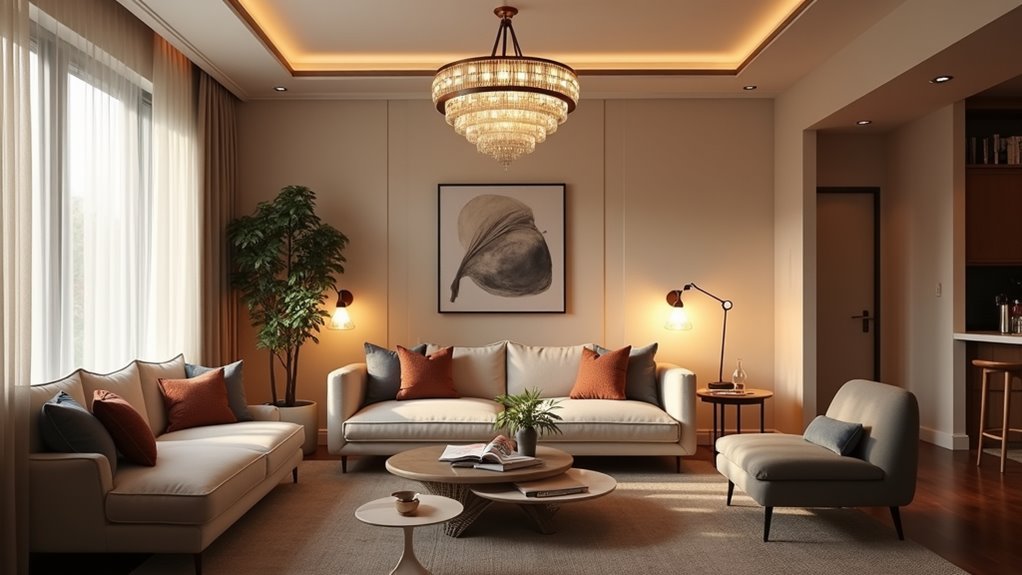
In a living room, specific lighting configurations are essential to enhance functionality for various tasks.
For reading areas, the ideal illumination should deliver focused light with a recommended brightness of 400 to 800 lumens to adequately illuminate pages without causing strain.
Similarly, functional lighting requirements extend to hobbies and crafts, where bright and adjustable fixtures are vital for detailed tasks, ensuring optimal visibility and reducing the risk of errors.
Reading Area Requirements
Reading area requirements encompass specific lighting essentials that enhance the experience and effectiveness of this calming activity. Creating a cozy reading nook involves careful selection of lamp styles and placement to ensure optimal lighting conditions.
- Aim for 300-600 lumens using a dedicated floor or table lamp for focused reading.
- Choose warm white lights (2700K-3000K) for leisure reading to reduce eye strain.
- Position lamps so light comes over the shoulder, illuminating the pages while avoiding glare.
- Use adjustable fixtures to direct light precisely, enhancing comfort and visibility.
These considerations are crucial for fostering an inviting and efficient reading area, transforming the living room into a sanctuary for book lovers.
Functional Lighting Levels
Effective functional lighting levels are essential for creating a versatile living room that caters to various activities and tasks. It is crucial to consider ambient adjustments and brightness variations based on specific needs, ensuring sufficient light for different tasks.
| Activity | Recommended Lux |
|---|---|
| General Tasks | 300-500 lux |
| Hobbies and Crafts | 800-1,000 lux |
| Cleaning and Household Tasks | 150-200 lux |
The flexibility of lighting is key, incorporating dimmers to adjust brightness. Layered lighting, combining ambient, task, and accent, allows for focused illumination in work zones. Adjustable fixtures, such as task lamps or floor lamps, can significantly enhance the living room’s functionality, catering to diverse activities.
Layering Light Sources for Balance
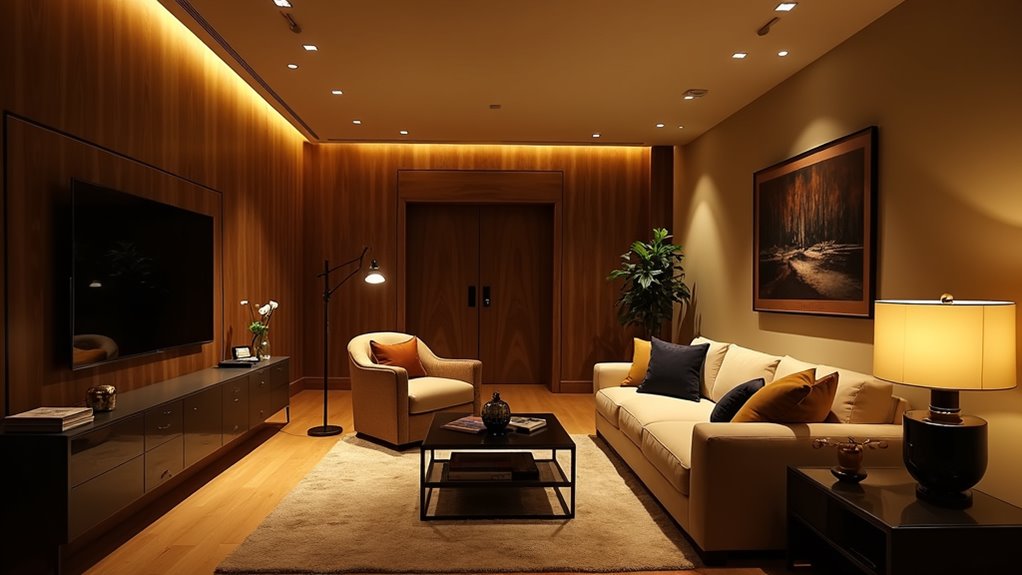
While the interplay of light sources may seem simple, achieving a harmonious balance in living room lighting requires thoughtful consideration of three distinct layers: ambient, task, and accent. Each layer serves a unique purpose, ensuring both functionality and aesthetic appeal.
- Ambient strategies set the foundational brightness, guiding overall visibility.
- Task lighting focuses light on specific activities to enhance usability and comfort.
- Accent techniques draw attention to artwork or architectural features, adding personality and depth.
Adjusting the intensity across these layers transforms the mood, making the space versatile for various times and occasions.
This layered approach not only meets practical needs but also elevates the living room from mundane to engaging, offering both warmth and sophistication.
Color Temperature Considerations
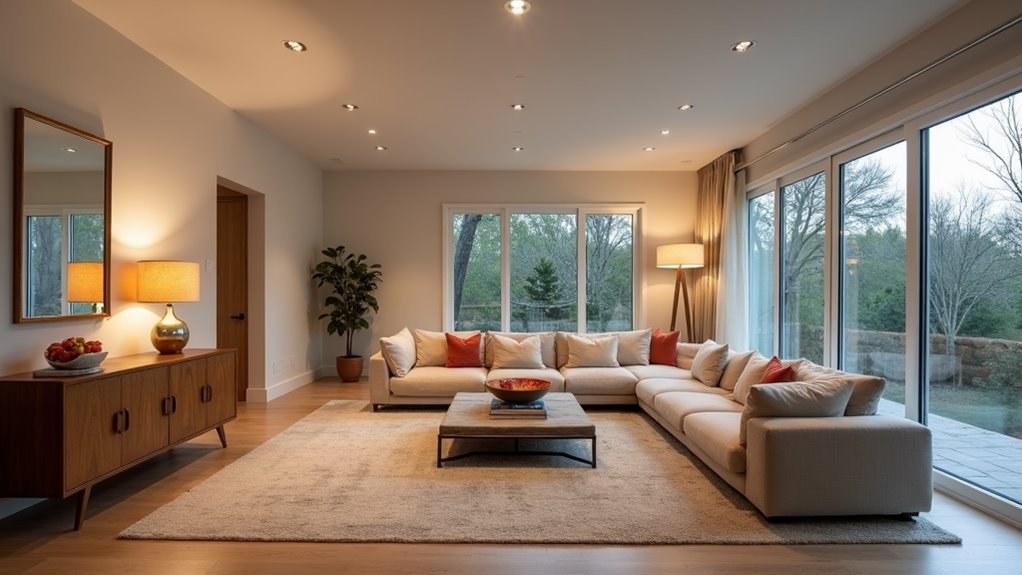
Color temperature plays a pivotal role in shaping the ambiance of a living room, providing a spectrum that ranges from warm whites to cooler tones.
Warm white lights, typically between 2700K and 3000K, foster a cozy and inviting atmosphere, ideal for relaxation and intimate social gatherings.
In contrast, neutral to cool temperatures, ranging from 3000K to 6500K, can create a more vibrant and alert environment, suitable for multifunctional spaces that require clarity and focus.
Warm White Ambiance
Warm white ambiance plays a significant role in creating a harmonious living room atmosphere, where the ideal color temperature ranges between 2700K and 3000K.
This warm hue enhances coziness, inviting relaxation and fostering a soothing atmosphere. Warm white light recaptures the natural glow of sunset, promoting comfort while minimizing eye strain.
- Enhances richness of wood tones and warm decor
- Creates an intimate and welcoming environment
- Softens wall colors, adding a gentle ambiance
- Best achieved through layered lighting designs
Using warm white LED bulbs and incorporating dimmable options enhances flexibility, allowing residents to adjust luminosity based on activities.
These elements converge to craft a living room that embodies cozy aesthetics, making the space both inviting and visually engaging.
Neutral vs. Cool Temperature
Lighting choices in a living room profoundly impact the overall atmosphere, making the distinction between neutral and cool temperature lighting critical for achieving the desired environment.
Neutral white light, ranging from 3900K to 4200K, offers a balanced ambiance that is ideal for showcasing art and creating a versatile space. This flexibility supports various activities while maintaining a modern feel.
In contrast, cool white light, with temperatures between 5000K and 6500K, introduces an energizing quality. Its bright sophistication enhances alertness but may compromise the warmth of natural materials.
Practical Tips for Optimal Lighting
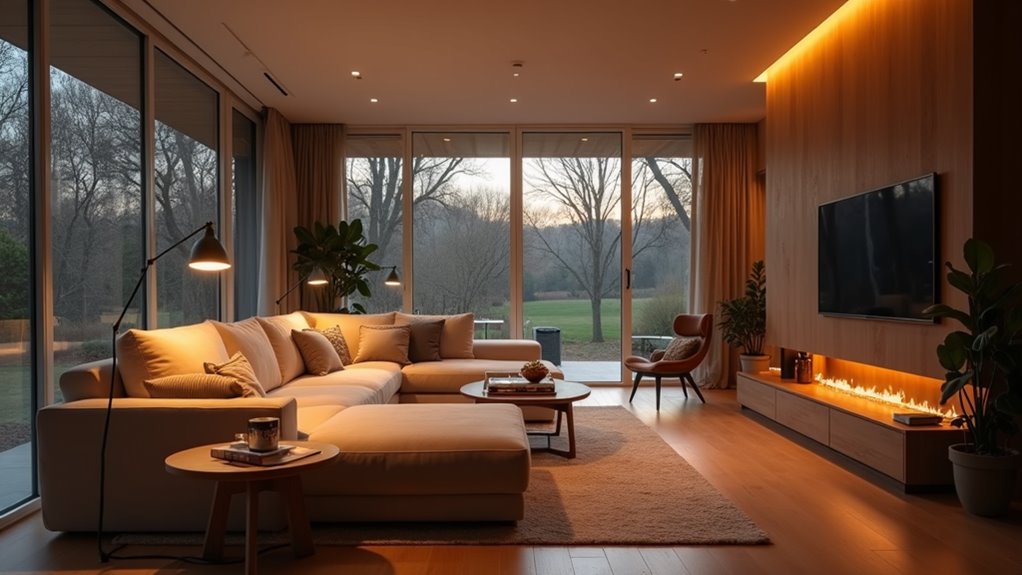
While creating an inviting atmosphere in a living room, it is essential to consider a multi-faceted approach to lighting that incorporates various sources and techniques.
A harmonious blend of fixture arrangement enhances the overall aesthetic while ensuring functionality. Here are practical tips for optimal lighting:
- Layer different types of lighting: ambient, task, and accent for balance.
- Use a mix of fixtures such as ceiling lights, floor lamps, and wall sconces to add depth.
- Position task lighting near reading areas to minimize shadows.
- Introduce dimmer switches or smart lighting for customizable brightness and mood.
These strategies will not only improve visibility but also elevate the ambiance of the living room through thoughtful lighting accents and varied illumination.


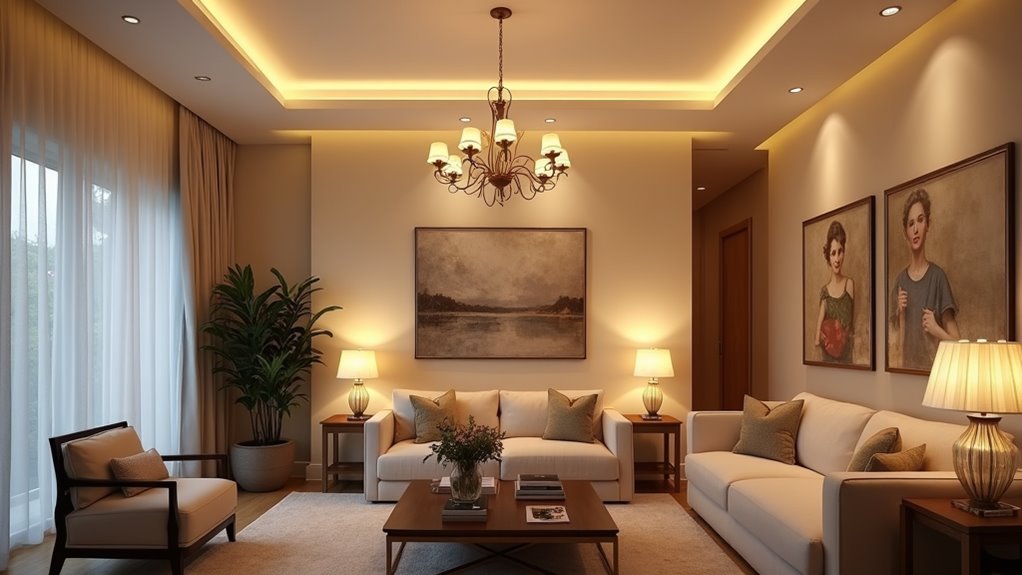
Bài viết cùng chủ đề:
Top 5 Living Room Track Lighting Fixtures for Modern Homes
7 Tips for Creating Stunning Living Room Cove Lighting Designs
3 Brilliant Ideas for Living Room Floor Lighting
7 Tips for Perfect Living Room Ceiling Recessed Lighting
10 Brilliant Living Room Overhead Lighting Ideas
Top 5 Semi-Flush Living Room Lighting Fixtures for 2025